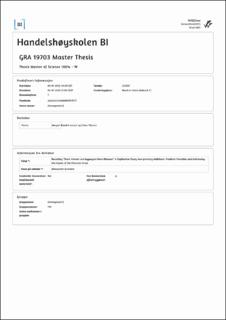Reuisiting "Short Interest and Aggregate Stoel! Returns": A Replication Study Incorporating Additional Predictor Variables and Addressing the Impact of the Financial Crisis
Master thesis

Åpne
Permanent lenke
https://hdl.handle.net/11250/3095522Utgivelsesdato
2023Metadata
Vis full innførselSamlinger
- Master of Science [1621]
Sammendrag
The primary purpose of this thesis is to reproduce the empirical findings of the original RRZ study and to reexamine the papers’ key claims. The first assertion is that " short interest is arguably the strongest known predictor of the equity risk premium identified to date." (Rapach et al., 2016). To examine this assertion, we shall employ an approach comparable to that of Priestley's study. Like RRZ, Priestley finds a high correlation between short interest and future stock returns over the study period of 1973 to 2015. The link also appears to persist when running out of sample testing, 1990-2015. The predictability of the short-interest variable, however, vanishes entirely when the year 2008 is omitted from both in and out-of-sample testing, i.e., for the period before and after 2008. Priestley concludes, therefore, that the entire predictability of short interest is due to the inclusion of the year 2008. This gap and the subsequent result that leads to Priestley's conclusion, which the RRZ publication completely ignores, will be examined, and this thesis will contribute to its resolution.
The second assertion is that " short interest outperforms a host of other popular return predictors." (Rapach et al., 2016). To refute this assertion, we would like to include four additional variables in the analysis. The original work by RRZ employs fourteen variables collected by Goyal and Welch (2008). However, Goyal and Welch discovered that their predictors performed poorly, particularly when predicting stock returns after the oil price crisis of the mid-1970s. (Goyal and Welch, 2008). In order to refute this claim and conduct a more recent comparison, we introduce new variables that have all been deemed among the most promising predictor variables after extensive testing and reexamination in the paper by Goyal, Welch, and Zafirov entitled "A comprehensive 2021 look at the empirical performance of equity premium prediction II." They investigate 29 variables from 26 separate articles that were published after Goyal and Welch (2008). Using OLS in sample univariate forecasting regression, they first replicated and validated the findings for the majority of predictors. The sample was then expanded to 2021 for all predictors. The OOS performance was tested before finally, the performance of each variable in four straightforward investing strategies was evaluated. (GWZ, 2021) Their results were generally regarded as disappointing. The majority of the investigated variables lost any predictive ability. However, a handful of them were deemed promising, and we included four that had monthly observations that matched with the short interest variable in our study.
Beskrivelse
Masteroppgave(MSc) in Master of Science in Finance - Handelshøyskolen BI, 2023